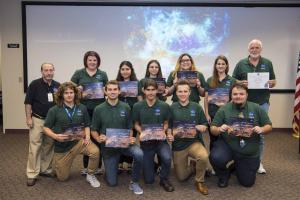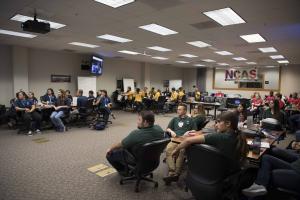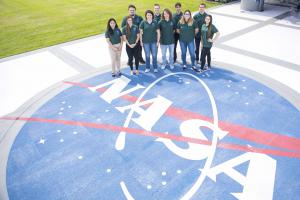Since Bryan Kolpin has been a student at Estrella Mountain Community College (EMCC), his opportunities to learn outside the traditional classroom have been out of this world.
Kolpin, who’s in his fifth semester, spent a week at the John C. Stennis Space Center in Mississippi last October as part of the National Community College Aerospace Scholars (NCAS) program. EMCC Professor Mike Farabee, who teaches geology and biology, encouraged Kolpin to apply for the program after Kolpin expressed a desire to go into the science field.
“I asked him, ‘What’s the right direction to go?’” Kolpin said.
Farabee asked him what type of geology he was interested in, and Kolpin told his professor he’s always loved space and planets and would enjoy researching them. Farabee said he had just the thing for Kolpin — a NASA program he’d seen earlier on EMCC’s internship webpage.
As with any internship, there’s an application process, and Carla Shelton, Student Service Specialist - Career & Transfer Center, helped Kolpin with his resume and cover letter.
“He took full advantage of the help from the center,” she said. “He is very receptive, humble, and has great potential.”
When the dust settled, Kolpin, along with 39 other lucky students, two of whom were also from EMCC, proved they had the right stuff and were a go for launch. To prepare for the trip to Stennis, the students spent five weeks over the summer completing an online course to learn about NASA's missions and research. The course consisted of discussions, live video chats with NASA experts, and various mission design challenges. Once they all touched down in the Magnolia State, the students broke up into four teams and built LEGO Mindstorm rovers to compete against each other during simulated Mars missions.
“The whole point of it is to try to guide us through the engineering process,” Kolpin said.
Although the rover competition was highly competitive, that didn’t stop teams from collaborating.
“We emphasized the need as a science community to be communicating with each other and sharing what we figured out,” Kolpin said. “Like if we figured out something new with the LEGO Mindstorms, we didn’t mind sharing that with the other teams. It didn’t matter who won, we’re learning the scientific process, building things, and field-testing them.”
He said his team worked really well together and everyone had his or her own job. His team had a couple of computer science majors so they were naturally chosen as programmers. Kolpin, who chose his specialty out of a hat, took on the role of the team’s test engineer.
“I was in charge of laying out the little test grounds we made within the classroom,” he said. “So I was doing a lot of measuring, making sure everything was exact, and it worked out pretty well, which was nice.”
The students’ days were long, leaving their hotel by 7 a.m. and staying at the space center until 6 p.m., and it was a lot of work, “but that work was fun,” Kolpin said.
Since his Stennis trip, Kolpin has become involved in NASA’s L’SPACE Virtual Academy, an online competency course, which will last throughout the spring semester.
“They’re trying to simulate an engineering job for us, and we’ll be put in groups based on time zones, and we’ll be given assignments and tasks online,” he said.
About 400 students throughout North and South America are participating. As with the NCAS program, the competency course is providing Kolpin with experience and networking, as well as being a strong addition to his resume.
Kolpin plans on graduating from EMCC in the fall of 2020.
“I’ll still be here for a while,” he said. “I still have a lot of math classes to take.”
He’s also saving a lot of money and taking advantage of the smaller class sizes.
“Lower-level classes at universities have at least 300 students and only one professor,” he said. “You can’t even ask questions. But here, we’ve got smaller classes, we’ve got this tutoring center, it’s more like a learning community.”
He should know since becoming a tutor in math, a subject he once struggled with.
He said he told Farabee he loves science but hates math and Farabee told him he just had to “stick it out” and that in three or four years, he’d be doing his dream job.
“And I said, ‘You know what? That’s a good point.’ And now I’m a math tutor here on campus.”
He explained that he’s an embedded tutor, meaning he takes the course with the students he’s tutoring.
“That’s to get them to hopefully be more comfortable with approaching me,” he said.
It also guarantees consistency with the way they solve problems and arrive at their answers.
“Sometimes, tutors will say something like, ‘I don’t know what your instructor might want, but here’s the answer and I know how to do it,’ and embedding tutors eliminates that.”
Kolpin also takes notes during every class, so if one of his students misses a class, he can share his notes.
“I’m helping them out however I can,” he said, adding tutoring is mutually beneficial. “If you’re tutoring someone else, it solidifies it for yourself, so it’s like I’m getting paid to study.”
Once he leaves EMCC, he’ll transfer to Arizona State University where he will study earth and space science. Eventually, he sees himself working for the university “forwarding that knowledge on to other students,” as well as being involved in the Lucy space mission, a 12-year journey to study Jupiter’s swarms of Trojan asteroids, set to launch in October 2021.
To learn more about the NCAS program as well as all internships EMCC has to offer, go to https://www.estrellamountain.edu/students/internships.


